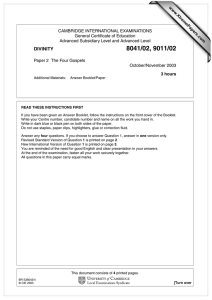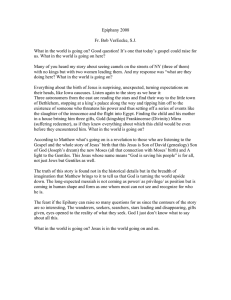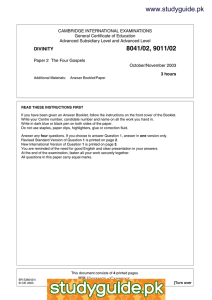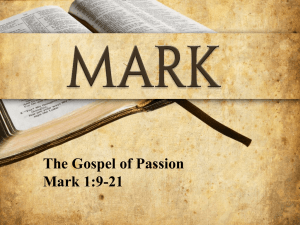8041 DIVINITY MARK SCHEME for the October/November 2010 question paper
advertisement
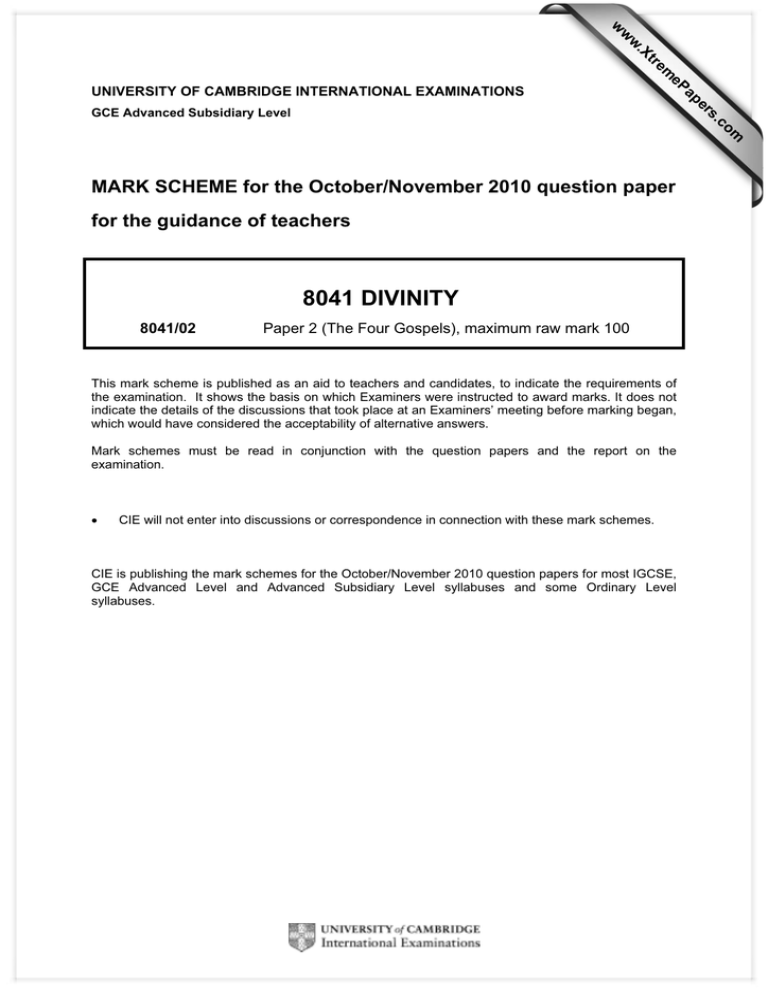
w w ap eP m e tr .X w UNIVERSITY OF CAMBRIDGE INTERNATIONAL EXAMINATIONS s er om .c GCE Advanced Subsidiary Level MARK SCHEME for the October/November 2010 question paper for the guidance of teachers 8041 DIVINITY 8041/02 Paper 2 (The Four Gospels), maximum raw mark 100 This mark scheme is published as an aid to teachers and candidates, to indicate the requirements of the examination. It shows the basis on which Examiners were instructed to award marks. It does not indicate the details of the discussions that took place at an Examiners’ meeting before marking began, which would have considered the acceptability of alternative answers. Mark schemes must be read in conjunction with the question papers and the report on the examination. • CIE will not enter into discussions or correspondence in connection with these mark schemes. CIE is publishing the mark schemes for the October/November 2010 question papers for most IGCSE, GCE Advanced Level and Advanced Subsidiary Level syllabuses and some Ordinary Level syllabuses. Page 2 1 Mark Scheme: Teachers’ version GCE AS LEVEL – October/November 2010 Syllabus 8041 Paper 02 (a) So all the generations from Abraham to David were fourteen generations, and from David to the deportation to Babylon fourteen generations, and from the deportation to Babylon to the Christ fourteen generations. (Matthew 1:17) Context: end of Matthew’s genealogy Points: • only in Matthew • significance of Abraham, David ... deportation to Babylon • significance of 14 generations ... 3 × 14 = 42 • significance of ‘the Christ’, a separate generation from Jesus (b) They do all their deeds to be seen by men; for they make their phylacteries broad and their fringes long, and they love the place of honour at feasts and the best seats in the synagogues, and salutations in the market places, and being called rabbi by men. (Matthew 23:5–7) Context: Discourse against the Pharisees in the last section of the main part of the Gospel. Points: • only in Matthew, but links with 6:1ff • who are they? – some discussion concerning the Pharisees – hypocrisy • phylacteries and fringes? – significance of them being broad and long • meaning and significance of ‘rabbi’ • contrast with the message of Jesus about humility and service (c) And he preached, saying, “After me comes he who is mightier than I, the thong of whose sandals I am not worthy to stoop down and untie. I have baptized you with water; but he will baptize you with the Holy Spirit.” (Mark 1:7–8) Context: From the description of John the Baptist and his ministry at the beginning of the gospel. Points: • who is preaching? And who is coming after? • significance of what is said about someone coming after…John the forerunner • significance of ‘the thong of whose sandals…’ • discussion concerning baptism by water • contrast with baptism with the Holy Spirit. What is meant by the latter? (d) And he came the third time, and said to them, “Are you still sleeping and taking your rest? It is enough; the hour has come; the Son of man is betrayed into the hands of sinners. Rise, let us be going; see, my betrayer is at hand.” (Mark 14:41–42) Context: Jesus and his disciples at Gethsemane, following the Passover meal (last supper). Points: • who came a third time? And who were still sleeping? • why were they sleeping? • comment upon ‘it is enough; the hour has come’ • significance meaning and use of the term Son of man here • who is the betrayer? And what is he about to do? © UCLES 2010 Page 3 Mark Scheme: Teachers’ version GCE AS LEVEL – October/November 2010 Syllabus 8041 Paper 02 (e) Soon afterward he went on through cities and villages, preaching and bringing the good news of the kingdom of God. And the twelve were with him, and also some women who had been healed of evil spirits and infirmities: Mary, called Magdalene, from whom seven demons had gone out, and Joanna, the wife of Chuza, Herod’s steward, and Susanna, and many others, who provided for them out of their means. (Luke 8:1–3) Context: Galilean ministry, after Luke’s story of the anointing at the house of Simon the Pharisee Points: • L material – only in Luke • comment upon Jesus’ mission to the ‘cities and villages’ – comparison with Luke 10 • comment upon the significance of the 12 being accompanied by women • comment upon ‘had been healed of evil spirits and infirmities’ • particular Lukan significance of the women, some of whom also appear at the Cross in all three synoptics • comment upon ‘provided for them out of their means’ (f) And he said to them, “What is this conversation which you are holding with each other as you walk?” And they stood still, looking sad. Then one of them, named Cleopas, answered him, “Are you the only visitor to Jerusalem who does not know the things that have happened there in these days?” (Luke 24:17–18) Context: The resurrection appearance on the way to Emmaus, after a discussion about the ‘things’ that have happened in Jerusalem recently Points: • who is ‘he’? And why were his companions looking sad? • L material • Comment upon Cleopas – not known from elsewhere • ‘visitor to Jerusalem’ – Passover time • comment upon how Luke begins and ends his gospel in Jerusalem • comment upon Lukan post-resurrection appearances generally (g) When the steward of the feast tasted the water now become wine, and did not know where it came from (though the servants who had drawn the water knew), the steward of the feast called the bridegroom and said to him, “Every man serves the good wine first; and when men have drunk freely, then the poor wine; but you have kept the good wine until now.” (John 2:9–10) Context: The first act of Jesus’ ministry in John at the wedding at Cana in Galilee Points: • only in John • significance of the position of this event in the gospel story • question of the unnecessary nature of the miracle • comment upon how this miracle is very different from the others in John • discussion as to the symbolic significance of the new wine • possible reference here to the superiority of Jesus’ message to the old law (cf synoptic new wine and old wine skins) © UCLES 2010 Page 4 Mark Scheme: Teachers’ version GCE AS LEVEL – October/November 2010 Syllabus 8041 Paper 02 (h) This man came to Jesus by night and said to him, “Rabbi, we know that you are a teacher come from God; for no one can do these signs that you do, unless God is with him.” Jesus answered him, “Truly, truly, I say to you, unless one is born anew, he cannot see the kingdom of God.” (John 3:2–3) Context: Early in John’s account of Jesus’ ministry, just after the first Passover Points: • who is ‘this man’? And why did he come by night? • only in John • significance of him saying ‘Rabbi, we know you are a teacher come from God’ • comment upon reference to ‘signs’ – what were they (cf also 2:23–24)? • comment upon the meaning of Jesus’ response • comment upon ‘the kingdom of God’ – what did this mean for John? © UCLES 2010 Page 5 Mark Scheme: Teachers’ version GCE AS LEVEL – October/November 2010 Syllabus 8041 Paper 02 Essay questions on specific gospels 2 Examine the importance of the Sermon on the Mount for Matthew’s gospel. Candidates will know the first part of the Sermon and many will make a great deal of the beatitudes. The linking of the sermon with the rest of the gospel makes this more difficult, but similar questions have been asked in 2000 and 2004. There are dangers that weaker candidates will include a lot of material from outside the Sermon (credit can only be given for this when it is used in comparison) or will simply rewrite the main teaching found in chapters 5–7. In addition to drawing out some of the important themes, good answers will place the Sermon in the context of Matthew’s technique and with regard to the Gospel as a whole. Points that could be made include: • the way Jesus interpreted the torah • the relationship between Christianity and Judaism • the lifestyle of the kingdom • the commitment to the kingdom • ecclesiological and liturgical material. 3 Assess Matthew’s treatment of Simon Peter in the discussions at Caesarea Philippi and at the Transfiguration. Questions on the Matthean Peter have appeared before, but have usually been of a more general nature. However, most answers have drawn heavily upon these well-known accounts and there’s plenty that can be said. In fact, it is likely and right that most answers here will draw upon the Caesarea Philippi account, but there ought to be more than a passing reference to the Transfiguration. The key to good marks lies in the quality of the assessment, but nothing original is expected here. Standard responses should raise many of the important points: • CP and T. Peter’s willingness to take the lead in answering questions; his uniqueness. • CP. Peter’s use of ‘Son of the Living God’, only found in Matthew. • CP. Issues of authenticity of 16:17–19. • CP. Discussion concerning ‘the rock’ and the name Peter. • CP. Matthew’s ecclesiological interests: use of ‘church’ here. • CP. Peter’s moral and doctrinal authority – no gospel parallel, but implied in Acts. What is meant by the “keys to the kingdom of heaven…”? • T. The inner circle • T. Peter’s understanding of the significance of the event, but, at the same time, his lack of understanding. • T. That Peter witnessed the Divine voice. © UCLES 2010 Page 6 4 Mark Scheme: Teachers’ version GCE AS LEVEL – October/November 2010 Syllabus 8041 Paper 02 “Mark emphasises the humanity of Jesus.” Discuss. A contrast between Marks’s picture of the human side of Jesus and the divine is acceptable, but the main emphasis and discussion should be upon the former. In addition, the question implies, but does not demand, a contrast between Mark and the other gospels. Main Markan points include: • The human emotions ascribed to Jesus, e.g. 1:41–43 (textual variant ‘being angry’), 3:5, 10:14, 8:12. • The rejection of Jesus at Nazareth (6:1–6) is important, especially when set aside parallel accounts in Matthew and Luke; Jesus is described as ‘the son of Mary’, he ‘could do no mighty works’ and was ‘amazed at their unbelief’. • Jesus’ admission that ‘only the Father knows the day and hour’ (13:32). • Reference to the picture of Jesus presented in Markan miracles, especially the inclusion of 7:31–37 and 8:22–26 (both omitted by Matthew and Luke). 5 Explain why Mark shows Jesus trying to keep his messiahship a secret. This essay will be based around Wrede’s theory and candidates should certainly be familiar with the traditional texts and arguments (e.g. the rebuking of demons, the silencing of the reporting of miracles, Jesus retiring from public view, etc.) but the question is asking for much more than a ‘list’ and brief discussion of points. There is definitely a command to silence in Mark, but is it with regard to Messiahship? It is likely that it is ‘false impressions’ that Mark’s Jesus wanted to prevent. But, it is very possible to argue against Wrede. Textual examples should be used in all types of answer, e.g. the ‘hardening theory’, the commands to silence, Peter’s confession (8:27–33), the Entry into Jerusalem (11:1–11), the Trial (14:61f), the uses of the term Son of man, etc. 6 Why did Luke write his gospel and for whom? This essay should be more than a list of Lukan themes: there should be a genuine attempt to put the gospel in context and deal with why Luke may have written it. There are plenty of areas for discussion, some of which being: • To correct the impression given by earlier and other accounts, e.g. Mark. • The dedication to Theophilus should certainly form a main part of the discussion (1:1–3)... to write ‘the truth’. • Possibly Luke is writing to defend Christianity to Rome. • A Gentile or Jewish audience? • To explain the role played by the Jews. • To explain the mission to the Gentiles. • Importance of seeing Luke in the wider context: reference to the book of Acts. © UCLES 2010 Page 7 7 Mark Scheme: Teachers’ version GCE AS LEVEL – October/November 2010 Syllabus 8041 Paper 02 Explain the significance of the parables of the lost sheep, the lost coin and the lost or prodigal son in Luke. There have been questions on Luke’s parables before, but not one specifically on Luke 15 (these parables are only found in Luke). Similarly, there have been many questions on Luke’s portrayal of Jesus’ mission to the outcasts, but not quite in this specific format. However, candidates should still have plenty to say in that the parables of the sheep, coin and (prodigal) son all portray clear elements of Luke’s presentation that also occur elsewhere in the gospel. Best answers should display a good knowledge of the text, but should also put it in the wider context of the gospel message as a whole: • forgiveness • love and patience • repentance • joy • sacrifice. 8 Discuss John’s theology of the Spirit. John’s teaching on the Spirit (Greek, Paraclete) is usually quite well-known, though not always in great depth. The essay should not simply relate the relevant passages, there should be some attempt to pull out the theology. • The overall context of the material is important: i.e. in relation to the ‘farewell discourse’ (14–16) and the Resurrection narrative (20–21). • Note that Jesus must go away before the Spirit can come (14:25, 16:7); the Spirit is then a link between the disciples and the risen Christ who will take over the work of Jesus’ incarnate life. • The Spirit will bestow enormous powers upon the disciples, but cannot do so until Jesus leaves. • The Spirit is given to the disciples by Jesus after his resurrection. • Discussion as to the function and power of the Spirit... − a counsellor who intercedes for man with God (14:16); − a provider of support (a comforter) for the disciples (14:18); − a provider of truth but not recognised by the world (14:17, 16:13); − dwelling in and among the disciples (14:17); − re-enforcing the message that Jesus had taught (14:25); − bearing witness to the disciples of Jesus (15:26); − able to convince the world concerning sin, righteousness and judgment (16:8); − having authority from the Father, as did Jesus, (16:13); − glorifying Jesus (16:14). − works ‘in’ the disciples, bearing witness to Jesus, revealing his will to them; − works within the world also bearing witness to Jesus but also acting as a judge. © UCLES 2010 Page 8 9 Mark Scheme: Teachers’ version GCE AS LEVEL – October/November 2010 Syllabus 8041 Paper 02 Discuss the importance of the ‘I am’ sayings in John’s gospel. The “I am” sayings are central to the Johannine Christology. This discussion should show a good general knowledge of the Christological points that arise and a specific knowledge of the “I am” sayings in particular. Although the term “I am” is used some 27 times in the gospel, the candidate will be expected to refer to at least some of the seven passages which contain extended discussion. Each of the ‘seven’ gives rise to plenty of discussion so examiners should not expect a detailed discussion of each. The essay demands more of an overview with specific points being brought out by way of example and illustration. Similarly, answers that are largely lists of points will not be among the top grades. The main ‘I am’ sayings are found in: • 6:35, bread of life • 8:12, 9:5, light of the world • 10:7, the door of the sheep • 10:11, the good shepherd • 11:25, the resurrection and the life • 14:6, the way, the truth and the life • 15:1, the true vine © UCLES 2010 Page 9 Mark Scheme: Teachers’ version GCE AS LEVEL – October/November 2010 Syllabus 8041 Paper 02 Essay questions on general gospel themes 10 To what extent can the miracles be seen as parables in action? Best answers will examine the way the miracles are used by the evangelists and by Jesus himself (if that can be separated from the evangelists’ own intentions). Material is too wideranging to be cited in much depth here but, clearly, the main part of the discussion will centre around how the gospel message of salvation and forgiveness in the kingdom of God (heaven) is demonstrated by Jesus’ ‘mighty works’ (synoptics) and ‘signs’ (John). There are numerous examples. Although, one might expect the best candidates to refer both to the synoptics and John, it should still be possible to get top marks by basing the answer on either tradition. 11 Examine the relationship between John the Baptist and Jesus in the gospels. Candidates will probably know the Baptist stories fairly well, quoting reasonably widely from the gospel sources. However, examiners should not necessarily expect references to any one gospel but should look at the way the question is answered as a whole. The substance of most essays will probably be from the synoptic, but additional material from John will obviously be most welcome and very relevant. Most answers are likely to focus upon how John is shown to prepare the way for the Messiah, and credit should certainly be given for a good knowledge and discussion of the texts. However, the best answers may develop deeper issues in the relationship between them and consider whether the gospels are hiding a tension that existed in the early church between the followers of Jesus and followers of John. 12 How far do the gospels present the kingdom of God as a future event? There is room for a lot of reference from the parables and to the well-known kingdom of God sayings. It is hoped that candidates will be aware of the eschatological problem in the gospels, showing an understanding of the difficulties in interpreting some of the material. Most references will be to the synoptics but there is room for Johannine material, especially in relation to realised eschatology. The revelation of Jesus’ kingship before Pilate (‘not of this world’) is interesting – in the ensuing discussion, Pilate completely misunderstands the nature of Jesus’ kingdom. Passages from Luke which refer to ‘the signs of the times’ and ‘Satan falling like lightning from heaven’ are worthy of discussion as, naturally, are the so-called ‘apocalyptic’ passages such as Mark 13. © UCLES 2010 Page 10 Mark Scheme: Teachers’ version GCE AS LEVEL – October/November 2010 Syllabus 8041 Paper 02 13 Assess Jesus’ debates with the Pharisees. There is plenty of material to use. Some answers will adopt a narrative approach – there really should be a definite attempt to ‘assess’ to score well. Better candidates will show some knowledge of the Pharisees, trying to understand their position rather than just condemning them. But don’t expect too much here. The following refers only to synoptic material, but Johannine material is perfectly acceptable: • they were not entirely hostile (i.e. he was invited to eat with them); he seems to have been at first an enigma and then a direct threat to everything they taught and believed; thus, some understanding is expected, for a good mark, of why he aroused their concern – his message and actions that offered forgiveness and salvation to everybody went against the whole concept of Pharisaic purity. • Jesus’ own attitude towards them is difficult – despite their hypocrisy, he still recognises their authority (Matt.23.2–3) – is this a Matthean redaction however? • There are many ‘conflict’ situations that are likely to form the basis of answers: the condemnation of Matt. 23 and Luke 11.37–54...the charge of hypocrisy; the grain fields sabbath incident (Mark 2, plls); the man with a withered hand sabbath healing (Mark 3, plls); the eating with unwashed hands (Mark 7, plls); the warning against the leaven of the Pharisees (Mark 8.15, plls); the question about paying taxes (Mark 12, plls, although Luke makes this a conflict with the priests); the anointing of the ‘woman of the city who was a sinner’ in the house of Simon the Pharisee (Luke 7.36–50, note that Matt. and Mark place this in the house of Simon the leper, not declared a Pharisee). 14 Examine the gospel accounts of the trial of Jesus before Pilate. There is plenty to say and most candidates know these stories quite well. Answers should evince more than just a list and narrative of the stories and their differences; the best answers will make a genuine attempt to evaluate the significance of these differences, focusing upon the way Pilate is represented in the accounts. Key points might include: • The differences between the accounts. • The relationship between Pilate and the Jewish authorities. • Pilate’s own character: is his washing of hands in Matthew really likely? His bringing in of Herod in Luke? • Specific points can be made on the Johannine account. © UCLES 2010




